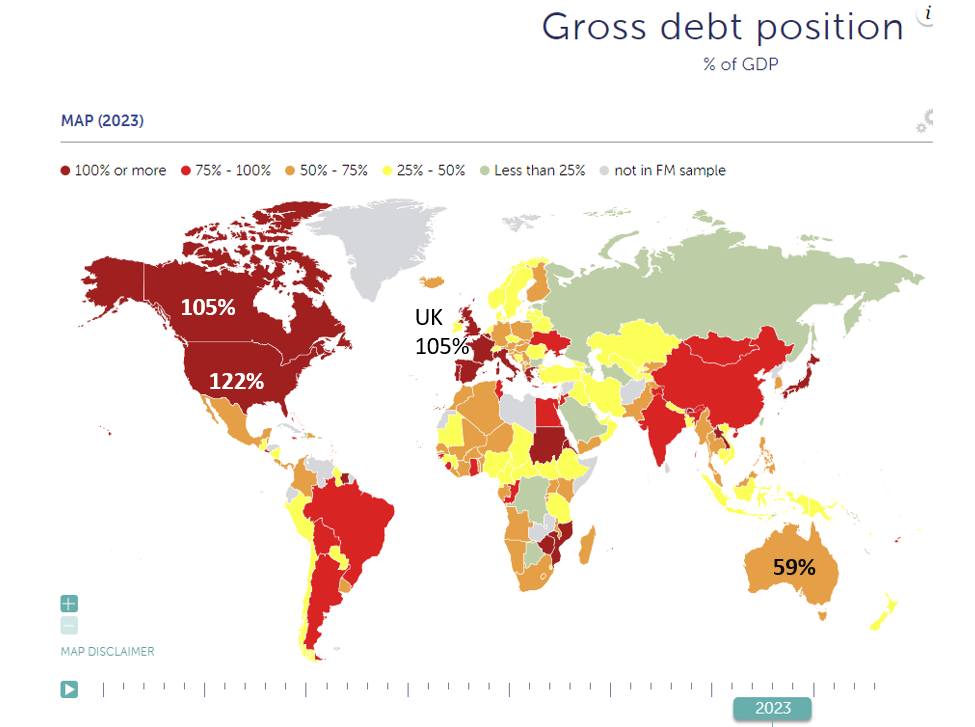
Photo: Bing AI
By Michael O’Neill.
American government debt concerns are all the rage this week. It started when Fitch Ratings downgraded the US Long-Term Foreign Currency Issuer Default Rating to AA+ from AAA on August 1.
Fitch said the new rating “reflects the expected fiscal deterioration over the next three years, a high and growing general government debt burden, and the erosion of governance relative to ‘AA’ and ‘AAA’ rated peers over the last two decades that has manifested in repeated debt limit standoffs and last-minute resolutions.”
Goldman Sachs dismissed the downgrade saying it was “no big deal,” while JPMorgan Chase Chairman Jamie Dimon called it “ridiculous.” He questioned how countries that rely on the US military to give them stability warranted a higher rating. He has a point. Germany has a Triple A rating despite Berlin being a mere 1380 kilometers from Kyiv and a likely target of Putin’s nuclear wrath.
Ignore the downgrade at your peril.
Investors have a nasty history of trashing markets when they become concerned about a countries finances. Just ask former UK Prime Minister Liz Truss. She was kicked to the curb last October following Chancellor of the Exchequer Kwai Kwarteng’s “mini-budget.” This dysfunctional duo concocted a plan to jump-start economic growth by slashing taxes and greatly increasing borrowing. The budget was widely criticized, with Moody’s Rating agency describing the tax-cuts as a “credit negative.” Gilt yields soared while stocks and the British pound collapsed. When the dust had settled, the failed “mini budget” cost the UK treasury £30 billion, Ms Truss her job and Mr Kwarteng sent to the back benches of the House of Commons.
The politicians went away but the issues remain. The UK is dealing with rising government debt, sticky inflation, and slowing growth.
The problems are compounded by Brexit as Britain disentangles itself from the European Union and its 448.0 million consumers, a decision that almost half (48.1%) of citizens did not support.
Britain is not the only country that experienced unrestrained government spending, as shown by the following IMF chart.

Source IMF-April 2023
Canada is also a bit of a basket case. The IMF calculates Canada’s debt to GDP ratio is at 105% of GDP, matching that of the UK. The Fraser Institute reported that the combined Federal and provincial net debt (inflation-adjusted) will be about $2.1 trillion in 2023, almost double the $1.1 debt in 2008.
The interest on that debt is rising. The Bank of Canada raised its benchmark rate to 5.00% on July 12 and many economists believe another rate increase is likely before year end.
The market reaction to the US debt downgrade should be a warning sign to Canadian investors and the government of Canada. Debt matters and eventually, unrestrained spending will have consequences.
Canada has a history of attracting large foreign capital inflows for natural resource projects and investment. Those investments are no longer welcome. The government’s strategy is to transition to a climate-change fighting, zero-emission economy where fossil fuels have no place, achieving net zero emissions by 2050.
To help achieve that goal, the government has imposed a carbon tax. Canadian’s get to pay more for everything while not accomplishing much. The Parliamentary Budget Office (PBO) agrees noting “Canada’s own emissions are not large enough to materially impact climate change.”
It is an ambitious project which requires Canada to replace the existing energy structure with green alternatives. It requires a massive scale of investment in infrastructure and a huge financial commitment by businesses, and households.
But it may be difficult to fund. The July 27 IMF bulletin on Canada noted that the economy is decelerating, and inflation is above target. It also highlights various economic and financial challenges that may have implications for the country’s fiscal situation.
Canada has embraced other measures to lower greenhouse emissions including planting trees; lots and lots of trees. Natural Resources Canada announced it was spending more than $100 million as part of it’s 2 Billion Trees Project.

Photo: Bing A!
Fitch Ratings’ emphasis on the issue of rising government debt sent both stock and bond prices tumbling. Despite this, there is not question as to which country, the US or Canada, is better equipped to cope with and manage high debt levels.
The US has a substantially larger economy and population. It is more open to international trade and is the global leader in technology, with the worlds largest tech companies along with having the biggest financial markets. Canada has trees and soon, windmills, and an expensive social system.
If investors are getting nervous about the size of the USD debt, they will be terrified if they look north of the border where politicians are “Going for Broke.”





